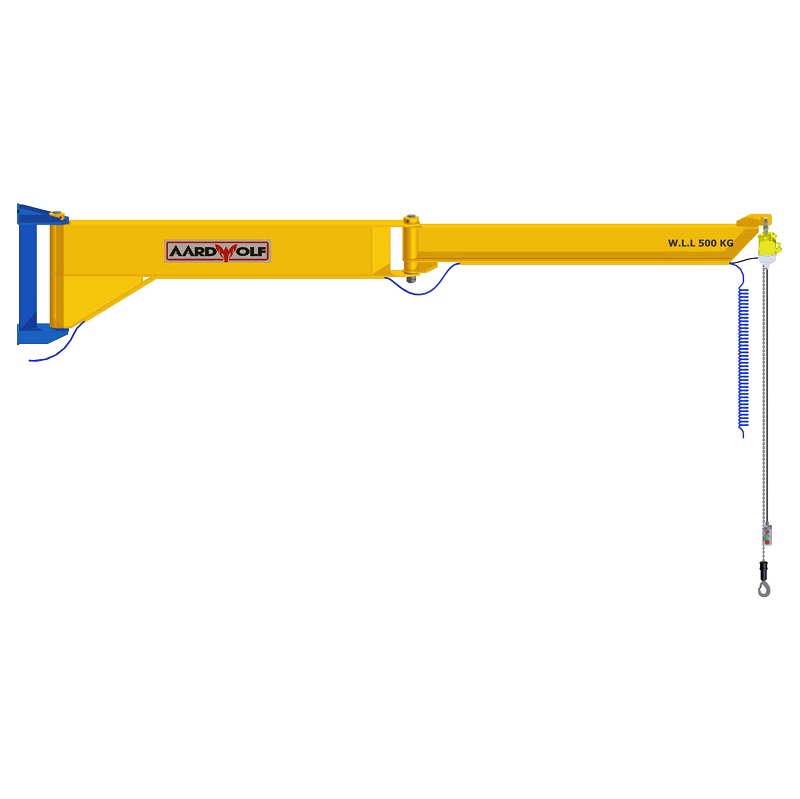In industrial settings, efficient lifting solutions are essential for productivity, safety, and space optimization. When it comes to indoor lifting applications, businesses often face a key question: should they use a jib crane or a gantry crane? Each system has its strengths, and the choice depends on your workspace, load requirements, and workflow.
With years of industry experience and engineering expertise, this guide offers a deep dive into the indoor applications of jib cranes and gantry cranes, based on principles of authoritativeness and trustworthiness. We’ll compare features, space efficiency, load capacity, mobility, and ideal use cases to help you make the best decision.
If you’re still unsure about installation, don’t miss Jib Crane: Safety, Setup, and Maintenance.
What Is a Jib Crane?
Table of Contents
ToggleA jib crane consists of a horizontal arm (jib) mounted on a vertical support (freestanding mast, wall, or ceiling). It supports a hoist and trolley system that operates in a circular or semi-circular motion. The design is ideal for repetitive, localized lifting.
Common Types of Indoor Jib Cranes:
- Freestanding – Anchored to the floor with 360° rotation.
- Wall-mounted – Space-saving option with 180°–200° rotation.
- Mast-type – Floor-to-ceiling mounted, doesn’t require a full foundation.
- Mast mounted – Similar to mast-type with additional structural stability.
- Articulating – Dual-arm system for navigating tight or obstructed spaces.
Explore the full product range: for more jib cranes products
What Is a Gantry Crane?
A gantry crane includes a horizontal beam supported by legs, often mounted on wheels or rails. It can span wide distances and lift heavy loads, making it suitable for large-scale applications. In indoor settings, however, its larger footprint and mobility may present challenges.
Indoor Space Efficiency: Jib Crane vs. Gantry Crane
Jib Crane – Winner in Compact Layouts
Wall-mounted and mast-type jib cranes are ideal for confined areas:
- Mounted on existing structural supports
- No floor interference
- Allows full use of floor space for operations or movement
Articulating jib cranes add flexibility by rotating around obstacles like workbenches, pillars, or shelving.
💡 If ceiling height is limited, mast-type jib cranes are often the best fit.
Gantry Crane – Requires Open Floor Space
While gantry cranes can be installed indoors, they:
- Demand more floor space for movement
- Obstruct pathways when stationary
- Require careful layout planning to avoid collisions
Load Capacity Indoors
For indoor applications, lifting needs rarely exceed 5 tons.
Jib Crane Capacity
- Freestanding jib cranes: Up to 5 tons for each (some models up to 10 tons)
- Wall-mounted and articulating types: 0.25 to 2 tons
- Mast-type cranes: 1 to 3 tons
🛠 For more details, see Jib Crane vs. Gantry Crane: Load Capacity and Use Cases
Gantry Crane Capacity
- Ranges from light-duty portable units (500 kg) to heavy-duty rail-mounted systems (50+ tons)
- Often excessive for standard indoor lifting
Verdict: ✅ Jib Cranes match most indoor lifting capacities efficiently and cost-effectively.
Installation & Setup Considerations
Jib Crane Setup
- Wall-mounted and mast-type versions require minimal installation
- Freestanding models need anchoring into a foundation
- Quicker installation and lower setup costs overall
See Jib Crane: Safety, Setup, and Maintenance for safety tips and setup steps.
Gantry Crane Setup
- Indoor installation requires designated pathways or track systems
- May need reinforced floors or additional clearance
- Longer installation time and higher labor cost
Verdict: ✅ Jib Cranes – easier to install and integrate indoors.
Mobility and Flexibility
Jib Crane
- Fixed base but rotating arm offers wide working coverage
- Articulating jib cranes increase reach and flexibility
- Ideal for repetitive tasks at designated stations
Gantry Crane
- Wheeled or rail-based, enabling lateral movement
- More suited for moving heavy loads across large spaces
Verdict: ✅ If you need localized mobility, jib cranes are more efficient indoors.
Ideal Indoor Applications for Jib Cranes
| Application | Recommended Jib Crane Type |
|---|---|
| CNC or lathe machine loading | Wall-mounted |
| Compact workstations | Articulating |
| Indoor maintenance operations | Mast-type |
| Fixed assembly lines | Freestanding |
| Tool and parts handling | Mast mounted |
💡 Need help selecting by industry? Visit Jib Crane vs. Gantry Crane: Ideal Applications Compared
Cost Comparison
Jib Crane Costs (Indoor)
- Equipment: $2,000–$10,000 depending on type
- Installation: Lower cost for wall and mast types
- Maintenance: Minimal
Gantry Crane Costs (Indoor)
- Equipment: $5,000–$50,000+
- Installation: Higher, especially with track systems
- Maintenance: More parts = higher upkeep
Verdict: ✅ Jib Cranes offer better ROI for most indoor businesses.
Final Verdict: What Works Better Indoors?
| Feature | Jib Cranes | Gantry Cranes |
|---|---|---|
| Space Efficiency | ✅ High | ❌ Requires open floor |
| Load Suitability | ✅ Medium-duty ideal | ✅ High-capacity |
| Installation Time/Cost | ✅ Low | ❌ High |
| Flexibility & Adaptability | ✅ Excellent with articulating | ✅ High, but large footprint |
| Best Use Indoors | ✅ Repetitive & compact tasks | ❌ Large-area transport only |
Conclusion:
For 90% of indoor applications—especially in workshops, factories, or production cells—jib cranes outperform gantry cranes in space, flexibility, cost-efficiency, and ease of use. Gantry cranes shine in large, open spaces, but for fixed, repeatable indoor operations, jib cranes – the smarter choice.
🔧 Browse for more jib crane products to find the model that suits your indoor layout and load needs.


















Please log in to leave a comment.